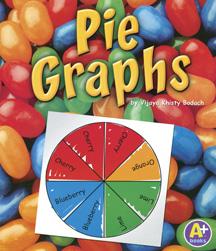Full Text Reviews: School Library Journal - 02/01/2008 PreS-Gr 2-These titles present math concepts in an easy-to-read/read-aloud format. The first book illustrates how to sort items and represent quantity using horizontal and vertical bars on a graph. Toy animals, fruit, pet type, and hair color are used as examples. Pictographs introduces the idea of organizing data to "show how many" with picture representations. Comparisons are made on a variety of topics: spotted and solid-color bunnies, how students get to school (walking, bus, and bikes), beverage preferences, and the kinds of flowers in an arrangement. One page shows the number of seeds planted in relation to the number of flowers that grew. Pie Graphs begins with a strawberry pie and six children. Over the first few pages, readers are led step-by-step through the process of charting how many had a piece and how many did not. The book suggests using a pie chart to graph favorite foods, the number of girls versus boys on a team, and the occurrence of jellybean flavors in a packet. The last title is devoted to keeping count with tally marks recorded in groups of five. This concept is illustrated with pick-up sticks and then translated to pen and paper. Sports preferences, the probability of heads or tails on coin flips, and score keeping are shown. Each title encourages readers to create their own graphs. Large, colorful photographs depict the concepts and feature ethnically diverse children. The photos and graphs complement the controlled-vocabulary texts, with a few sentences per page. Good choices for math collections.-Alison Grant, Ruby S. Thomas Elementary School, Las Vegas, NV Copyright 2008 Reed Business Information. - Copyright 2008 Publishers Weekly, Library Journal and/or School Library Journal used with permission. Booklist - 10/15/2007 It’s hard to find books that effectively explain math concepts for young children; this crystal clear entry in the Making Graphs series does just that. The book sensibly opens with an episode involving slices of strawberry pie, then points out that “pie graphs are not just for pies.” The examples, eight in all, stay close to children’s immediate concerns (a group’s pizza-topping preferences; the distribution of flavors in a jelly-bean package) and then show how a circle can be divided and shaded to express the information. A big strength of this title are the pictures, primarily professional photographs of children in scenes set up to closely match the text. Part of the publisher’s A+ line of “read-aloud concept books,” the book has oversize dimensions and large, clear type that will work well for sharing with groups. Teachers will have no trouble finding ways to use the scenarios here to lead into classroom discussions and activities about this key curriculum topic. - Copyright 2007 Booklist. Loading...
|



